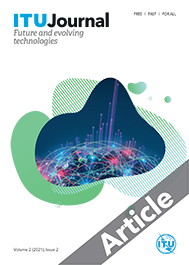|
Infrastructure sharing model to connect the unconnected in rural areas
|
Authors: Ida Sèmévo Tognisse, Ahmed Dooguy Kora, Jules Degila
Status: Final
Date of publication: 6 December 2021
Published in: ITU Journal on Future and Evolving Technologies, Volume 2 (2021), Issue 2, Pages 129-138
Article DOI : https://doi.org/10.52953/JVDQ1380
|
 | Abstract:
One of the major problems the telecommunication industry faces in providing connectivity to the unconnected, particularly in rural and remote areas, is the lack of infrastructure in these areas. Indeed, deploying a network in an isolated area can be more expensive for an operator than in an urban area, while the return on investment is not possible. This is the primary cause of the coverage divide. To remedy this, in this work, we propose a techno-economic analysis of infrastructure sharing. First, we develop a mathematical model of the overall cost of extending a mobile network in rural areas. Different scenarios involving infrastructure sharing at varying levels of deployment are then presented. Then, using the models proposed in each scenario, we make a case study to deduce the most economically advantageous scenario for operators to extend their networks to remote areas. This case involves the sharing of passive infrastructure and also the sharing of active resources in a cloud-RAN. Based on the proposed model, our simulation results show that while passive sharing is beneficial, active sharing using cloud-RAN as technology increases this benefit. This work also indicates and highlights the technical constraints to be respected in the sharing for this scenario. |
|
Keywords: Digital divide, infrastructure sharing, rural areas, total cost of ownership
Rights: © International Telecommunication Union, available under the CC BY-NC-ND 3.0 IGO license.
|
|
| Detalle del artículo | Artículo | Precio | |
|---|
| 0
| Gratuito | Descargar |
|
|
| |